The secondary waves, which are started at the upper edges of the cutting, reach the ear and give still a good idea of the character of the noise and position of the train. The range of the ear greatly exceeds that of the eye, not only in relation to the variety of wave-lengths by which it may be impressed, but yet more as to variations of intensity. Just as sunshine and shadow during the day indicate merely variations in illumination without the complete extinction of light, so noise and sound-shadow are merely relative terms, the latter not necessarily implying the complete extinction of sound; for in air diffraction usually plays so important a part as to forbid complete extinction, and to prevent all sharpness of definition at the edges of the shadow.
When the medium is water instead of air, some new phenomena are noticeable. In 1826 Daniel Colladon's classic experiments on the velocity of sound in water were performed on the Lake of Geneva. The source of sound was a large bell, from which vibrations were conducted through the water several miles away to an elastic membrane stretched across the expanded opening of a partially submerged hearing-trumpet. They were thus given to the air within the trumpet and conveyed to an ear applied at its smaller end above the water. A bell when struck sends forth a variety of tones, and it is often hard to determine which of these is most prominent. Usually that of deepest pitch is the slowest to die away in air, and often it penetrates to the greatest distance. Colladon made the remarkable observation that in water the lower tones are conducted off to but a short distance before their energy ceases to produce the sensation of sound; while the initial stroke is propagated much further, and is then perceived as a short, sharp, almost clicking sound, without definite musical character. Placing the hearing-trumpet behind a wall which projected out into the water, the decrease of intensity was much greater than under similar conditions in air, and the demarkation of the region of shadow was decidedly more noticeable.
Still more interesting than the experiments of Colladon were those made in the Bay of San Francisco in 1874 by Prof. John Le Conte and his son, Mr. Julian Le Conte. The source of sound was not such as would give a definite pitch, like a bell, but the quick, violent, single impulse due to the explosion of dynamite employed in the blasting of rocks which obstructed the channels. The intensity of the shock thus propagated was such as to be felt as a blow on the feet of a person seated in a boat three hundred feet or more from the detonating cartridge, and to kill hundreds of fish. Several vertical posts or piles, each about a foot in diameter, projected from the ground out of the water in the neighborhood. A stout glass bottle was suspended in the water about a foot in the rear of one of these piles (Fig. 1), within the geome-
